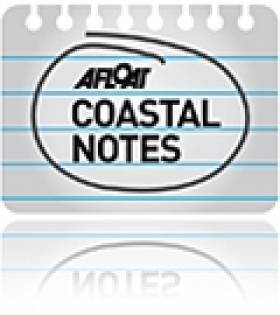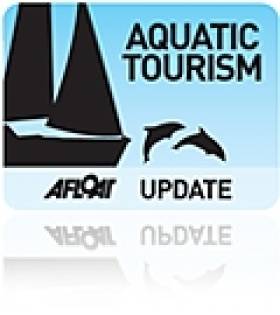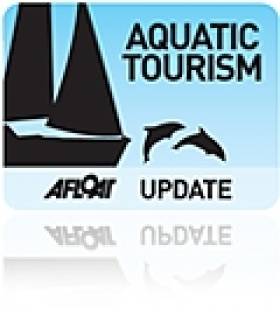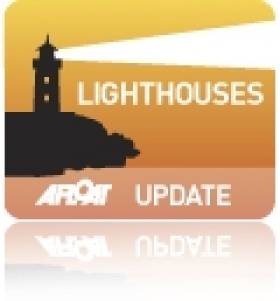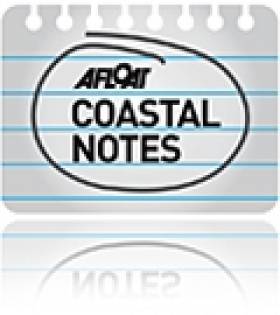Displaying items by tag: Wild Atlantic Way
Creedon's Wild Atlantic Way TV Programme Needs Your Help!
#creedonswildatlanticway – The Wild Atlantic Way, the magnificent West Coast of Ireland - is it the 'land of your heart's desire', as described by William Butler Yeats? RTE's John Creedon is about to find out in his new 3 part series for RTE One, Creedon's Wild Atlantic Way.
"My car is always happiest when it's pointed west," claims John and it's just as well because he's about to travel this epic 2,500 kilometre trip from Kinsale in Cork right up to Donegal's Malin Head. But he needs your help.
"I know there are some real hidden gems out there so I'm putting out the call," said John. "I want people to get in touch and tell me all about them. It could be anything, that little boreen that leads to your secret beach, or the place where you're guaranteed to catch a fish...or a wave!"
But this series is also all about the characters John meets up with. "You might know someone, an uncle, a cousin or even a neighbour", he says "and you've always thought they should be recorded for posterity. They're the people I want to meet, the big personalities that make the west coast such a unique place."
So if you want to contact John with your hidden gem, you can get in touch. Email [email protected]
But the Wild Atlantic Way is more than just a road trip. The sea will be John's highway and he wants to discover just why this beautiful yet savage landscape exerts such a hold on us.
"The West Coast has witnessed Cromwell's tyranny, the famine's devastation and the scourge of emigration," says John. "But it's managed to survive and for many it's become a sanctuary and refuge. It's this reimagining and reinventing that I really want to try and explore."
Landscape, history, characters, poetry, food and a window into the lives of the people who live where the land meets the ocean – all of this will be part of Creedon's Wild Atlantic Way which is due to air on RTE One this Summer.
Video Captures Drone's-Eye View Of Wild Atlantic Way
#CoastalNotes - Via TheJournal.ie, check out this breathtaking video by photographer Peter Cox, who mounted a camera to a remote operated drone to capture stunning coastal vistas on the Wild Atlantic Way.
Using little more than consumer-level tech, Cox was able to film incredible aerial shots of the kind previously only available those with big budgets on expensive helicopter shoots.
But he says his experiments have not been without their crashing failures, including one potentially disastrous moment when an engine tore off his drone at Loop Head.
TheJournal.ie has more on the story HERE.
Wild Atlantic Way Is Magazine's Choice For 'Best Tourist Attraction'
#WildAtlanticWay - The Wild Atlantic Way was recognised as ‘Best Tourist Attraction’ at the third InBusiness Editors' Choice Awards at a ceremony in Dublin's Hibernian Club.
Fáilte Ireland says it invested €10 million during 2014 in what's Ireland’s first long-distance touring route, stretching from the Inishowen Peninsula in Donegal to Kinsale in Co Cork.
And the news comes in the same week as the Loop Head Peninsula, a key attraction on the route, was named as one of the world's top 100 sustainable travel destinations.
"The enthusiasm out there for this project is impressive and not only amongst tourism businesses but also in the wider community," said Fiona Monaghan, head of the Wild Atlantic Way project for Fáilte Ireland. "The key to success for this initiative is its authenticity – not just the places but also the people of the Wild Atlantic Way.
“With its capacity to drive extra visitor footfall, mobilise communities and showcase the best of the West Coast of Ireland, the Wild Atlantic Way is set to be one of the most significant developments in modern Irish tourism and to be a significant engine of regeneration for rural Ireland," she added.
"I have no doubt that there is at least a decade of growth in the Wild Atlantic Way and is already luring visitors to Ireland as they seek to explore the longest defined coastal route in the world.”
Irish companies and individuals were recognised at the InBusiness Editor’s Choice Awards, which honour outstanding achievement in the Irish business community. Winners were selected based on the broad criteria of growth, profile of business, range of services and customer care.
Launch of Tourism Ireland’s Marketing Plans 2015
#TourismIrelandPlans - Tourism Ireland's marketing plans to promote Ireland overseas in 2015 and beyond was launched by Minister for Transport, Tourism and Sport, Paschal Donohoe T.D at an event yesterday and attended by tourism industry leaders from around the country.
The organisation aims to build on this year's growth in overseas tourism and to welcome 7.74 million visitors to Ireland in 2015 – surpassing the previous record year of 2007. This figure will represent growth of +6% over 2014 and deliver almost €4 billion to the Irish economy (+7%) next year.
In the longer-term, the aim is to welcome some 10 million visitors to Ireland in 2025, contributing €5 billion to the economy and helping to sustain about 250,000 jobs.
• Tourism Ireland sets its sights on record year for Irish Tourism in 2015
• Ambitious targets will see overseas tourism deliver 10 million visitors and €5 billion for Irish economy in 2025
New TV ads – part of Tourism Ireland's global advertising campaign, 'Jump into Ireland' – were also unveiled. The ads will launch in January 2015 in 22 markets around the world – on television, in cinema and online. The soundtrack for the ads is the hit single "Love Like This" by popular Dublin rock band Kodaline.
Building on this year's success and sustaining growth into the future is at the heart of Tourism Ireland's strategy in 2015. The plans will see Tourism Ireland prioritise those markets that offer the best return on investment, in terms of holiday visitors and revenue i.e. Britain, North America and Mainland Europe.
Ireland's 'best prospect' visitors will be targeted more closely – with distinctive holiday experiences, events and special offers tailored to their interests and designed to trigger their 'must go now' impulses. Emerging markets of high potential will also be targeted, particularly China and India, where Tourism Ireland will highlight the new British-Irish Visa Scheme.
Important factors working in our favour for 2015 include new access developments; as well as consumer confidence, which is returning in our key source markets. The Ireland 'brand' or image abroad is strong; continued product investment enhances our offering overseas – particularly investment in the Wild Atlantic Way. (see report of launch on Afloat.ie)
Exchanges rates for sterling and the dollar are favourable; and the lower price of oil will help make air and sea routes more sustainable.
In 2015, Tourism Ireland will continue to leverage its strength in digital and social media. The organisation is now the fourth most popular tourism board in the world on Facebook (about 2.65 million fans), number three on Twitter and number two on YouTube.
Promoting the Wild Atlantic Way will continue to be a major focus of Tourism Ireland's activity around the globe next year; the organisation will also showcase Dubline, the new Dublin Discovery Trail.
Next year marks 150 years since the birth of world-renowned Irish poet and Nobel laureate, WB Yeats, a colossus on the world literary stage and an important figure in the history of our country; Tourism Ireland will promote Yeats 2015 – particularly to its 'culturally curious' audience. And, next year has also been designated ID2015 (the year of Irish design), a showcase of the best of Irish design.
This special year will help raise the profile of Irish design and designers and show how they reflect our unique culture, helping to give us 'stand-out' on the world stage.
Speaking at the launch, Minister Donohoe, said: "The international tourism marketplace is a competitive one so it is crucial that we show no signs of complacency where the increase in our overseas visitor numbers is concerned. We must continue to identify the most effective ways to attract tourists to Ireland, so that we can support the jobs we have in the sector and help create new ones in the future. Government policies, such as reducing the rate of the air travel tax to zero from April 2014 onwards and retaining the reduction of VAT at 9% on tourism-related services in Budget 2015, support this objective. Similarly, the focus we have placed on newer markets, such as China and India, through the introduction of the British-Irish Visa Scheme, encourages visitors from further afield in greater numbers.
"There is a direct correlation between tourism growth and good connectivity. The expansion of ferry services on the Irish Sea provided a major boost for tourism in 2014 and the promise of further expansion of air services in 2015 bodes well for the future. Continuing to offer distinctive holiday experiences that are tailored to specific markets, such as golfers and adventure tourists, will also help keep us ahead of the game. Building on the success of the Wild Atlantic Way, developing a branding model for Dublin through the recently established Grow Dublin Tourism Alliance and developing a unifying tourism proposition for the south and east region will ensure that all parts of Ireland benefit from our tourism marketing strategy.
I am always delighted to lend my support to the promotional efforts of all of our tourism agencies in the work that they do. And I am committed to the continuation of that support throughout 2015 and beyond."
2014 Performance
Latest estimates indicate that, by year end, 7.3 million people will have visited Ireland in 2014, representing an +8.8% increase over 2013, with growth recorded from all market areas. Revenue generated by international visitors is expected to be approximately €3.7 billion, +10.9% increase over last year. Niall Gibbons, CEO of Tourism Ireland, said: "2014 is set to be another record year for visitor numbers from North America, Germany, France and Spain, as well as from our long-haul markets.
Throughout the year, Tourism Ireland undertook a packed programme of promotions, to bring Ireland to the attention of travellers everywhere. Thousands of opportunities were created for potential visitors around the world to read, hear or watch positive messages about Ireland; Tourism Ireland estimates that this media exposure is worth an estimated €280 million in equivalent advertising value."
2015 and Beyond
Tourism Ireland's targets for 2015 will see Ireland welcome 7.74 million visitors, representing growth of +6% over 2014. Commenting on the year ahead, Niall Gibbons said: "Following a successful 2014, ambitious targets have been set for 2015 and beyond. We will continue to place a major focus on promoting the Wild Atlantic Way, as well as on Dubline (the Dublin Discovery Trail). We will promote specific themes, including ID2015 and Yeats 2015. And we will highlight the new British-Irish Visa Scheme in China and India, which will enable Chinese and Indian visitors to visit both Ireland and the UK, including Northern Ireland, on a single visa of either country."
Access developments for 2015 include a new Aer Lingus flight from Washington DC to Dublin, a new United Airlines flight from Chicago, a new Transavia service from Paris, as well as other new air routes like a Finnair service from Helsinki and SAS flight from Gothenburg in Sweden.
Wild Atlantic Way Heritage Tourism Project Launched
#WAW – A pilot project that has resulted in the development of a heritage trail on 60km of the Wild Atlantic Way (WAW) is being hailed as a template for future similar developments along the West of Ireland coastal route from Donegal to West Cork.
Clare County Council, in partnership with Loop Head Tourism, The Heritage Council and Fáilte Ireland, today launched the Loop Head and Kilkee Heritage Trail on the Wild Atlantic Way.
The guide features 18 local heritage attractions including the West Clare Railway, the Church of the Little Ark, Kilkee Victorian Town and the Bridges of Ross, as well as other local WAW Discovery and Signature Points.
Through consultation with the local community and stakeholders, the pilot project also features recommendations to make it more streamlined and cost effective for other local communities to replicate the same project along the 2,500km WAW.
Cllr. John Crowe, Cathaoirleach of Clare County Council welcomed the selection of Kilkee and the Loop Head Peninsula as the location for the pilot project and said he hoped other WAW communities will be inspired to further enhance their tourism product offering.
He added: "The development and promotion of lesser known attractions is often overlooked even though they hold the key to revitalising the domestic tourism sector. The Loop Head Peninsula boasts a variety of local heritage sites and attractions, along with some of Ireland's most unique and breathtaking scenery. The development of this Trail complements work undertaken throughout the Loop Head Peninsula in recent years to develop and promote the local tourism product."
Congella McGuire, Heritage Officer with Clare County Council said Loop Head's growing reputation as a visitor destination has evolved as a result of "a bottom-up, community focused approach."
"The project is aimed at promoting a greater sense of understanding of the history, heritage, folklore and culture along the Wild Atlantic Way (WAW) route by connecting with and placing the local community at the core of this and future WAW projects," she said.
Ms. McGuire noted that a systematic project methodology was used in the development of the heritage trail.
"The first key task was the identification of potential heritage trail sites by the project steering group and key community representatives. An inspection of each of the 27 potential heritage sites was undertaken where a set of site assessment criteria were applied and this potential list was refined. This was followed by research and interpretation tasks surrounding the 18 sites on the final list and the Maritime History, Folklore and Traditions, Flora and Fauna, and Built, Military and Religious Heritage of the area," she commented.
Ms. McGuire continued: "The recommendations, processes and checklists outlined in the final project report should allow the project to be replicated and help future projects be more efficient, streamlined and cost effective. They also provide a clear model for working with the local community and stakeholders and will help deliver high quality and consistent design ready interpretation content along the entire WAW."
Cillian Murphy, Chairperson of Loop Head Tourism commented: "We are delighted to have had this opportunity to work with The Heritage Council, Failte Ireland and Clare County Council on developing the first destination led heritage trail on the WAW. It is testament to the hard work done by the group over the last number of years that we were chosen to be the pilot project on how to showcase our local heritage to visitors, enticing them to slow down and spend a little longer in each destination along the Wild Atlantic Way."
"The resulting Loop Head Peninsula Heritage Trail is a shining example of what can be achieved when statutory agencies and local community groups co-operate in a bottom up approach to tourism development. County Clare has placed itself at the forefront of responsible tourism development in Ireland over the last number of years and this project is further proof of that decision paying dividends and benefiting both locals and visitors alike," added Mr. Murphy.
The Loop Head and Kilkee Heritage Trail on the Wild Atlantic Way features Carrigaholt Castle and Bay, Bridges of Ross, Kilkee Cliffs and Pollock Holes (WAW Discovery Points), Church of the Little Ark (WAW Signature Point), Blackweir Bridge, Doonaha Ringforts, Tullig Famine Village, Corbally and Coosheen (Heritage Areas), Bishops Island, Dunlicka Castle, Loop Head, Pilots Memorial and Kilbaha Bay, Grave of the Yellow Men, Rinevella Bay and Submerged Forest, Kilcredaun Churches and Holy Well, Kilcredaun Churches and Holy Well, Querrin Pier and the West Clare Railway (Heritage Sites).
The Trail Z-Card will shortly be made available throughout the region.
First Phase of All-Ireland Lighthouse Trail Planned For Next Summer
#Lighthouses - The Irish Examiner reports on the new All-Ireland Lighthouse Trail that's planned to launch next summer, eventually linking 20 lights across the border.
The initial phase of the project, which was first announced more than a year ago, will see redevelopment of five lighthouses in Antrim, Down and Donegal, including Fanad Head Lighthouse.
And it's envisaged it will complement the Wild Atlantic Way coastal tourism route from Donegal to Cork.
The Commissioners of Irish Lights website has more on the All-Ireland Lighthouse Trail, which will link up 20 of the island of Ireland's more than 70 lights.
Plans are also in motion to provide for accommodation along the route, plus visitor centres to highlight each lighthouse's story and heritage.
'The Blueway' – the New Way to Discover Our Coastline
#NewBlueWaySites -The Blueway, a new national initiative to complement the Wild Atlantic Way and to encourage visitors to discover our coastline, was launched by Minister of State for Tourism & Sport, Michael Ring.
The Blueway is a pilot programme to encourage visitors to engage with the sea by developing trails for water activities such as snorkeling and kayaking and highlighting local activity providers and events at the five Blueway locations in counties Mayo and Galway.
Speaking at the launch, Minister Michael Ring said –"Blueways offer an entirely new perspective on Ireland's magnificent wild Atlantic coastline. The Blueway initiative provides visitors with a safe haven to immerse themselves in some of the most glorious coastal waters anywhere in the world."
The five coastal Blueway sites are in Counties Galway and Mayo - Boffin Harbour on Inishbofin, Killary Fjord in Leenane, Keem on Achill Island, and Mannin Bay and Old Head (Louisburgh) in Mayo.
Recent research indicated that over 84,000 overseas visitors engage in water-sports every year when on holiday in Ireland with the vast majority of those taking part in kayaking and snorkeling.
The Blueway project supports the development of kayaking and snorkeling water trails in the pilot locations to support communities to develop new experiences for visitors along the Wild Atlantic Way.
Fiona Monaghan, Head of the Wild Atlantic Way Programme with Failte Ireland, said –"We are delighted to support this initiative, which sees the timely development of an excellent Wild Atlantic Way water sports experience, and provides the visitor the opportunity to engage with the sea. We have seen first-hand the success of the Greenway in Mayo which boosted local tourism with over 200,000 visitors last year. As a maritime variant of that initiative, we hope the Blueway can enjoy the same level of interest from visitors both at home and abroad."
Fáilte Ireland established a group, chaired by Dr Richard Thorn Chairman of the Irish Underwater Council, to progress the pilot programme which included representatives from Canoeing Ireland, the Rural Development Programmes of South Mayo, the Leader companies, Comhdhail na Oilean, Forum Connemara as well as Galway and Mayo County Councils and representation from the Leave no Trace initiative.
Over the summer months a series of "Blueway Days" will take place at the pilot locations to encourage visitors to engage with the sea.
These 'Blueway Taster days' have been devised to create awareness of the Blueway locations and the activities that are on offer.
Local activity operators will be available on the day to provide tuition and equipment together with safety advice to anyone that is interested in snorkelling /kayaking at these locations.
So whether you're a land lubber or a salty sea dog, local instruction and support will be there to suit every ability.
In addition to support from Failte Ireland, the project is supported by the Leader programme.
More Funding Announced For 'Wild Atlantic Way'
#WildAtlanticWay - TheJournal.ie reports that an additional €1.4 million in State funding will be winging its way to the new Wild Atlantic Way scheme.
Earlier this year Kinsale Yacht Club was announced as the starting point of the 2.500km coastal tourism route that was first launched almost a year ago.
Presented to 300 top overseas tour operators attending Meitheal 2013 - Ireland’s largest tourism trade fair - by Minister of State for Tourism Michael Ring and Fáilte Ireland, the ambitious project constitutes Ireland’s first long-distance driving route winding from Cork to the Inishowen Peninsula in Donegal.
The latest funding injection will provide for the completion of the Galway Greenway walking and cycling trail - itself a phase of a long-term scheme to connect the City of the Tribes to the capital along the route of the Royal Canal.
Downpatrick Head in Mayo will also receive funds for a visitor centre connected to its famous blowhole Poll na Seantainne. And Kinsale will get money to help restore the Signal Tower at the Old Head of Kinsale.
TheJournal.ie has more on the story HERE.
'Wild Atlantic Way' Coastal Tourism Route Launched
#CoastalNotes - Minister of State for Tourism & Sport Michael Ring today (23 April) unveiled the final route for the Wild Atlantic Way, a new coastal tourism route running from Donegal to Cork.
The minister joined Fáilte Ireland to present the final route to 300 top overseas tour operators attending Meitheal 2013, Ireland’s largest tourism trade fair.
The Wild Atlantic Way will be Ireland’s first long-distance driving route, stretching from the Inishowen Peninsula in Donegal to Kinsale in Co Cork, and offering future visitors an opportunity to discover the west coast.
The 2,500km final route was unveiled following a comprehensive public consultation process and includes 156 strategically placed discovery points for tourists along the way.
While the route unveiled today comprises the main spine of the Wild Atlantic Way, a series of looped itineraries off the spine are also planned to further develop the experience for visitors.
Speaking today, Minister Ring said: “The Wild Atlantic Way is a very exciting project and I’m certain it will be a major tourism attraction. But to make it happen we all need to get on board.
"There has been a great response so far and I’m encouraging tourism operators, local authorities, business people and residents to stay involved to get this over the finishing line."
Overseas tour operators were given an advance ‘sneak-peek’ of the route last night at a Fáilte Ireland welcome event in the Convention Centre Dublin when they were treated to the premiere of the video trailer above to show them just what their clients can expect along the route from next year on.
Paddy Mathews, manager of destination development with Fáilte Ireland, believes the project will be a great addition to what Ireland has to offer visitors.
“Developing a route like this is an important part of ensuring Ireland is able to provide visitors with an unforgettable experience," he said. "It will open up a huge number of towns and attractions to them and showcase the scenery and unique culture of the West Coast of Ireland providing easy access to a range of experiences along the route.
“Now that the route has been finalised we will be focusing our efforts on turning all this preparatory work into a reality – an international driving route to rival the best in the world.”
Fáilte Ireland has been working with all the local authorities along the West Coast as well as the leader companies, Údaras na Gaeltachta and the Western Development Commission.
Full details of the Wild Atlantic Way are available on the Fáilte Ireland website HERE.





























